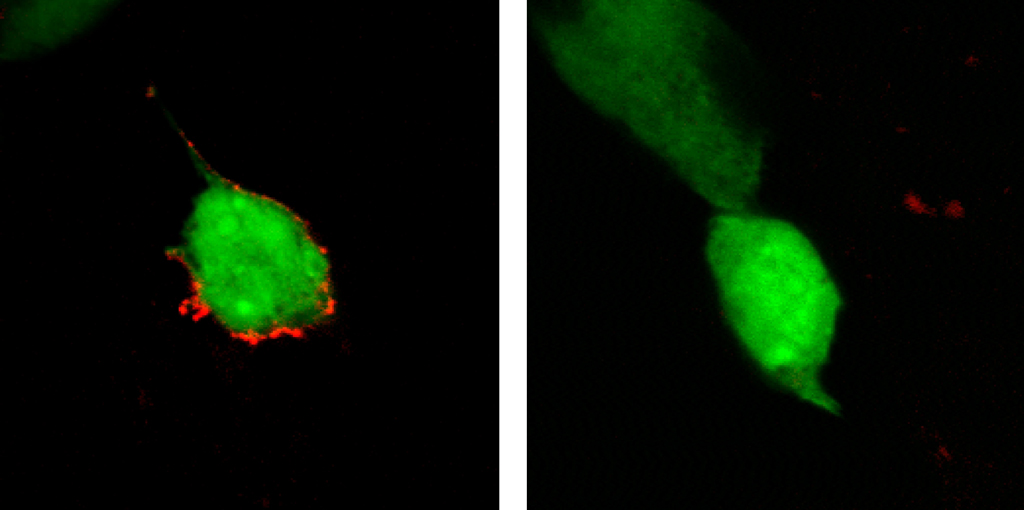Jul. 4, 2013 Research Highlight Biology
A new link between eye and ear
A gene responsible for building neural circuitry contributes to proper development of both the eye and ear
 Figure 1: SLITRK6 mutations in myopia patients yield proteins (red) defective in cell surface localization. Proteins from the wild-type gene localize to the cell surface (left) in mammalian cells, while mutant proteins do not (right). © 2013 American Society for Clinical Investigation
Figure 1: SLITRK6 mutations in myopia patients yield proteins (red) defective in cell surface localization. Proteins from the wild-type gene localize to the cell surface (left) in mammalian cells, while mutant proteins do not (right). © 2013 American Society for Clinical Investigation
Myopia is a visual defect arising from abnormalities in the length of the eyeball and is widespread throughout the world. Hearing loss is also relatively common, affecting nearly 1 in 500 individuals by the age of 9. Although rarely occurring together, a study of a small number of individuals affected by both deficits by Jun Aruga of the RIKEN Brain Science Institute, in collaboration with colleagues from around the world, has now revealed a gene with a prominent role in the development of both the eye and ear1.
Almost a decade ago, Aruga’s group discovered that a particular gene, SLITRK6, is active only in sensory tissues including the eye, ear and the thalamus region of the brain. “The thalamus is often described as a ‘relay station’ for mediating sensory signal processing,” he explains. His work drew notice from geneticists in the United States and United Kingdom who had uncovered striking evidence linking SLITRK6 to human myopia and hearing loss, and Aruga proposed a collaboration between the three teams to explore this connection.
The UK team identified an Amish family with three sibling children manifesting severe myopia and hearing loss, while the US team studied a Turkish family with four similarly affected adult siblings. Using two different genomic analysis strategies, each team identified inherited mutations in the SLITRK6 gene that appeared to be associated with these sensory problems. Follow-up work with a third family from Greece identified an additional SLITRK6 mutation, further supporting this hypothesis.
Aruga’s team subsequently performed a series of experiments to determine the functional impact of these mutations. The SLITRK6 protein normally localizes to cell surfaces, where it helps to coordinate synapse formation and neuron growth. However, the mutant versions of the protein fail to reach the membrane (Fig. 1) and exhibit impaired function. Previous experiments showed that mice lacking SLITRK6 suffer hearing loss, and Aruga’s team proceeded to examine eye development in these animals. They were surprised to find abnormalities that had been previously overlooked. “This gene deficiency resulted in increased axial length of the eye, as seen in myopia,” he says.
Although this link between eye and ear development is unexpected, both the retina and hair cells of the inner ear feature the same subtype of synapse, whose formation may be governed by SLITRK6. In future studies, Aruga hopes to explore the details of SLITRK6 function and how it helps determine the structure of the mature eye.
References
- 1. Tekin, M., Chioza, B. A., Matsumoto, Y., Diaz-Horta, O., Cross, H. E., Duman, D., Kokotas, H., Moore-Barton, H. L., Sakoori, K., Ota, M. et al. SLITRK6 mutations cause myopia and deafness in humans and mice. The Journal of Clinical Investigation 123, 2094–2102 (2013). doi: 10.1172/JCI65853
